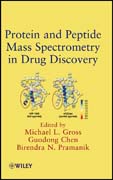
Protein and peptide mass spectrometry in drug discovery
Gross, Michael L.
Chen, Guodong
Pramanik, Birendra
INDICE: Preface. Contributors. Part I. Methodology. 1.Ionization Methods inProtein Mass Spectrometry (Ismael Cotte-Rodriguez, Yun Zhang, Zhixin Miao andHao Chen). 1.1 History of the development of protein mass spectrometry. 1.2 Laser based ionization methods for proteins. 1.3 Spray-based ionization methodsfor proteins. 1.4 Ambient ionization methods. 1.5 Conclusions. 2. Ion Activation and Mass Analysis in Protein Mass Spectrometry (Cheng Lin and Peter OConnor). 2.1 Introduction. 2.2 Ion Activation and Tandem MS Analysis. 2.3 Mass Analyzers. 3. Target Proteins: Bottom-up and Top-down Proteomics (Michael Boyne and Ron Bose). 3.1 Mass Spectral Approaches to Targeted Protein Identification. 3.2 Bottom-up Proteomics. 3.3 Top-down Approaches. 3.4 Next generation approaches. 4. Quantitative Proteomics by Mass Spectrometry (Jacob Galan, Anton Iliukand W. Andy Tao). 4.1 Introduction. 4.2 In-cell Labeling. 4.3 Quantitation via Isotopic Labeling of Proteins. 4.4 Quantitation via Isotopic Labeling on Peptides. 4.5 Label-free Quantitation. 4.6 Conclusions. 4.7 Acknowledgment. 5. Comparative Proteomics by Direct Tissue Analysis using Imaging Mass Spectrometry(Michelle L. Reyzer and Richard M. Caprioli). 5.1 Introduction. 5.2 Conventional Comparative Proteomics. 5.3 Comparative Proteomics using Imaging MS. 5.4 Conclusions. 5.5 Acknowledgements. 6. Peptide and Protein Analysis using Ion Mobility-Mass Spectrometry (Jeffrey R. Enders, Michal Kliman, Sevugarajan Sundarapandian and John A. McLean). 6.1 Ion Mobility-Mass Spectrometry: Instrumentation and Separation Selectivity. 6.2 Characterizing and Interpreting Peptide and Protein Structure. 6.3 Applications of IM-MS to Peptide and Protein Characterization. 6.4 Future Directions. 7. Chemical Footprinting for Determining Protein Properties and Interactions (Sandra A. Kerfoot and Michael L. Gross). 7.1 Introduction to Hydrogen/Deuterium Exchange. 7.2 Experimental Procedures. 7.3 Mass Spectrometry-based HDX in Practice. 7.4 Protein footprinting via Free-radical Oxidation. 7.5 Chemical Cross Linking. 7.6 Selective and Irreversible Chemical Modification. 7.7 Conclusion. 8. Microwave Technology to Accelerate Protein Analysis (Urooj A. Mirza, Birendra N. Pramanik and Ajay K. Bose). 8.1 Introduction. 8.2 Microwave Technology. 8.3 Summary. 8.4 Acknowledgements. 9. Bioinformatics and Database Searching (Surendra Dasari and David L. Tabb). 9.1 Overview. 9.2 Introduction to Tandem Mass Spectrometry. 9.3 Overview of Peptide Identification with Database Searching. 9.4 MyriMatch-IDPicker Protein Identification Pipline. 9.5 Results of a Shotgun Proteomics Study. 9.6 Improvements toMyriMatch DatabaseSearch Engine. 9.7 Applications of MyriMatch-IDPicker Pipeline. 9.8 Conclusion. 9.9 Acknowledgements. Part II. Application. 10. Mass Spectrometry-based Screening and Characterization of Protein Ligand Complexes in Drug Discovery (Christine L. Andrews, Michael R. Ziebell, Elliott Nickbarg and Xianshu Yang). 10.1 Introduction. 10.2 Affinity
- ISBN: 978-0-470-25817-0
- Editorial: John Wiley & Sons
- Encuadernacion: Cartoné
- Páginas: 488
- Fecha Publicación: 21/10/2011
- Nº Volúmenes: 1
- Idioma: Inglés
